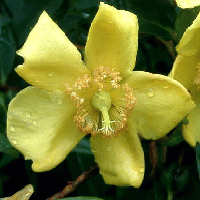 |
CLUSIACEAE (formerly Guttiferae) - The St. John's Wort Family
This is a Family of about 1000 species of trees and shrubs occurring throughout the world, mostly in tropical regions. It has many species of economic importance, ranging from large trees grown for their timber, those grown for drugs, dyes, resins, and essential oils used in cosmetics, to edible fruits, including Garcinia mangostana , (Mangosteen) and Mammea americana (Mammey Apple). Many species of St. John's Wort have a long history of use in traditional medicine. |
Characteristics of this Plant Family:
Leaves, Stem & Roots ~ The stems are usually woody and the leaves are simple and undivided, usually opposite, with no stipules. The stems and leaves, and also the flowers, have glands producing essential oils, fats and resins.
Flowers ~ The flowers have four or five sepals and four or five petals. They may be single or in groups. Sometimes they are bisexual, and sometimes male and female flowers are borne on separate plants. There are two whorls of five bundles of stamens. The outer ring is usually sterile.
Seeds ~ The ovary is superior, and the fruit is usually a capsule. Sometimes the seeds have wings or an aril.
Members of this Family usually have:
Undivided leaves occurring opposite one another
Glands on the leaves
Five sepals and five petals
Many stamens
and are mostly woody shrubs and trees